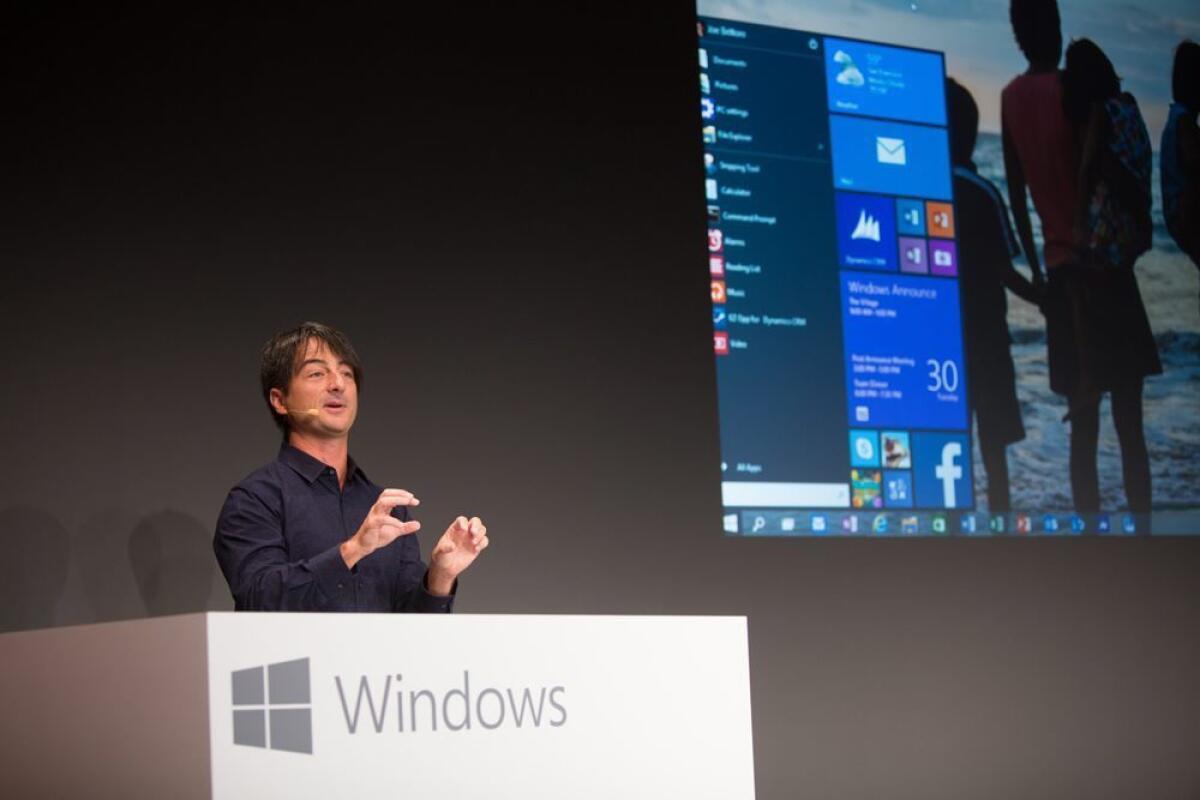9? Microsoft goes straight to Windows 10

- Share via
Skipping over Windows “9,” Microsoft unveiled Windows 10 on Tuesday to steer far away from displeasure with the company’s current computer operating system.
Expected to go on sale in the middle of next year, 30 years after version 1.0 launched the iconic brand, Windows 10 is the first built to power any size gadget from smartphones to TV screens, company executives announced Tuesday.
Tuesday’s unveiling was geared toward large companies that drive Microsoft’s high-margin software licensing business.
The early details might not be enough to get those businesses excited about a major software overhaul, but they represented progress for the troubled technology giant, analysts said.
“This is a pretty audacious move for Microsoft,” said Rob Enderle, a technology analyst who used Windows 10 demos on Tuesday. “They are trying for something much bigger than they have ever done before.”
The user experience on Windows 10 more closely resembles classic Windows rather than the grid-style layout Microsoft switched to when it released Windows 8 two years ago. The latter design was panned for confusing users and slowing down tasks, leaving Windows 7 far more popular than Windows 8. Only 20% of businesses run Windows 8, according to Forrester Research.
As Microsoft demonstrated Windows 10 for the first time, officials showcased multi-tasking features meant to improve productivity. Among the simple improvements, Windows will recommend what apps a user might want open side-by-side.
“All the things people hated about Windows 8 are pretty much gone, and all the things people wanted carried over from Windows 7 are back,” Enderle said. “All the things I knew they needed to address, they did.”
Windows 8 had too steep of a learning curve, Microsoft executives said, but Windows 10 will have virtually none. For instance, rather than force people with touch-screen computers to manually switch from typing by touch to a Bluetooth keyboard, Windows 10 will automatically adjust a display depending on whether a keyboard or a mouse is attached.
Upgraded security features in Windows 10 should make smartphones and computers running the operating system safer for consumers to use for work. And IT managers will be pleased by a new program that will let them install updates to Windows 10 at their own pace, technology experts said.
But many businesses have spent the last couple of years upgrading from Windows XP to Windows 7, as Microsoft ended support for XP earlier this year. The company must do more to show them that taking another leap in the short term is worthwhile, said Rob Breza, a financial analyst who follows Microsoft for Sterne Agee.
“So far, it’s not going to be a sea-changer to force companies off Windows 7,” he said. “If it’s a nice to have versus a got to have, that’s how I think about.”
Windows 10 is the first retooling of the operating system since the product’s former chief Steven Sinofsky left Microsoft two weeks after the Windows 8 release.
He later joined a venture capital firm, and Terry Myerson took over Microsoft’s operating systems group. In a statement, Myerson called Windows 10 “the first step of a whole new generation” that would “unlock new experiences for customers to work, play and connect.”
The wording reflected new Microsoft Chief Executive Satya Nadella’s shift to think more about what apps and services Microsoft could sell rather than focusing on sales of the software and devices they are running.
But by building a solid foundation, Microsoft could rope people back from Apple, which has increasingly attracted application makers, business customers and consumers with a unified look between the iPhone, iPad and Mac computers.
“A more unified Microsoft platform will be music to the ears of” IT leaders, said Daniel Ives, a financial analyst covering Microsoft for FBR Capital Markets. It “could also open up massive opportunities on the consumer front (cloud, mobile, apps) over the coming years as the common user-interface across devices adds familiarity/ease-of-use,” he wrote in a note to investors Tuesday.
Microsoft invited technology experts to try Windows 10 beginning Wednesday -- part of the what the company said was the largest pre-launch testing process it’s undertaken.
Patrick Moorhead, principal analyst at Moor Insights & Strategy, said Microsoft grew enamored with Apple after the iPhone and tried to follow its secretive development approach with Windows 8. Whether the renewed effort at early engagement prevents a repeat of the Windows 8 frustration will depend on how tuned in Microsoft stays over the next year.
“They’ve shown Windows 10 won’t get in the way, but they need to work harder now on showing that value proposition,” he said.
Twitter: @peard33




